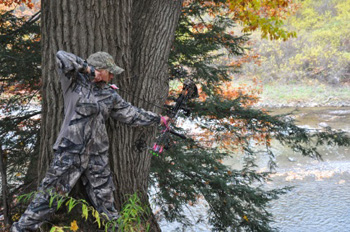August 22, 2011
For Immediate Release
Contact::
Helena, MT –Tim Aldrich, President of the Board of Montana Wildlife Federation (MWF), announced the retirement of Craig Sharpe . For12 years, Craig has been the well known and highly respected Executive Director of the Montana Wildlife Federation. Craig has played key roles in the successful efforts of the Federation to protect and enhance Montana’s public wildlife, lands, waters and fair chase hunting and fishing heritage. His leadership and vision on issues as far reaching as the elimination of Game Farms, the delisting of wolves and clarification of Bridge Access are some recent examples that have the Montana Wildlife Federation a leading voice both in Montana and Nationally when it comes to wildlife conservation and defending our outdoor heritage.
Sharpe’s lasting contributions were recognized at the recent Annual Meeting of the Montana Wildlife Federation when he received the Don Aldrich Conservationist of the Year Award. In his nomination it was stated that, “In many ways, for over twelve years Craig has been the glue keeping MWF, the State’s leading Hunter and Angler based conservation organization, focused and effective. His knowledge and passion for the mission of MWF provide a strong basis for what he does both internally and externally…No matter what needs to be done, he is the advisor, the resource to be contacted and involved in getting it accomplished, always with the needed degree of excellence. He is the ‘captain of the ship’ and often the crew that rows the boat.”
“Craig will be sorely missed,” said Corey Fisher Vice President of MWF for Internal Affairs. “He has left his own legacy of conservation in Montana and he is truly appreciated and respected by many.” Fisher said that the Board of Directors will start the process to find a new Executive Director. Sharpe’s retirement became effective August 15th, and the Board has named Ben Lamb as the acting Executive Director to help fulfill the duties and responsibilities so ably performed by Craig.
As we celebrate Craig’s storied career, the Montana Wildlife Federation will continue to serve Montana’s hunters and anglers in to the future. It is doubtful that the attempts which MWF helped to successfully defeat in the 2011 Legislative session will decrease over time. Those bills would have undermined conservation funding, eliminate the scientific management of wildlife and pitted hunters against other interests. MWF remains committed to our mission to protect and enhance Montana's public wildlife, lands, waters, and fair chase hunting and fishing heritage.
“No organization has invested so much in the future of Montana’s wildlife and outdoor heritage as much as has MWF. I am proud to have served the hunters and anglers of Montana through my role at MWF, but now I look forward to spending some time chasing birds, catching fish, and paddling my kayak down a lazy river,” said Sharpe.
Long time friend and confidant Jim Posewtiz had the final word on Craig, “Craig has demonstrated his dedication, commitment and passion for Montana’s wildlife, and those of who hold wild country and all wildlife near and dear. No one in Montana is more deserving of a retirement in the fields, forests and streams.”
The Montana Wildlife Federation is an organization of conservation minded people who share a mission to protect and enhance Montana's public wildlife, lands, waters, and fair chase hunting and fishing heritage. www.montanawildlife.com

 Surveys show that three of every four Americans approve of legal hunting, and support is trending upwards. As long as the majority of citizens continue to see this sporting tradition as fair, safe and meaningful, hunting will remain a privilege of citizenship--as well as a boon to conservation.
Surveys show that three of every four Americans approve of legal hunting, and support is trending upwards. As long as the majority of citizens continue to see this sporting tradition as fair, safe and meaningful, hunting will remain a privilege of citizenship--as well as a boon to conservation. For some people, hunting for “sport” implies frivolity: killing for fun.
For some people, hunting for “sport” implies frivolity: killing for fun.


 On July 26, the U.S. House of Representatives’ Committee on Natural Resources’ Subcommittee on National Parks, Forests and Public Lands held a hearing on a bill intended to release some U.S. Bureau of Land Management (BLM) and USDA Forest Service wilderness study areas and roadless areas from protection. H.R. 1581—the “Wilderness and Roadless Area Release Act of 2011”—is creating controversy within the conservation community, reports the Wildlife Management Institute.
On July 26, the U.S. House of Representatives’ Committee on Natural Resources’ Subcommittee on National Parks, Forests and Public Lands held a hearing on a bill intended to release some U.S. Bureau of Land Management (BLM) and USDA Forest Service wilderness study areas and roadless areas from protection. H.R. 1581—the “Wilderness and Roadless Area Release Act of 2011”—is creating controversy within the conservation community, reports the Wildlife Management Institute.



